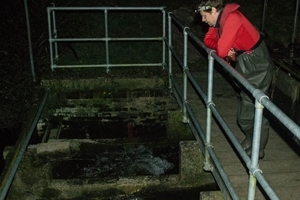 Brown trout and sea trout are the same species with individuals, often siblings, taking on very different strategies and migrations. Whilst we know some individuals spend most of their life inhabiting their natal streams and others go through a genuine smolting process and migrate to sea, we know very little about the extent of migration and habits of those fish that do something in between. On the River Frome we have observed individuals that migrate downstream but don’t seem to enter the sea, and others that have smolted seem to return so quickly to freshwater that we wonder whether they simply inhabit the lower river.
Brown trout and sea trout are the same species with individuals, often siblings, taking on very different strategies and migrations. Whilst we know some individuals spend most of their life inhabiting their natal streams and others go through a genuine smolting process and migrate to sea, we know very little about the extent of migration and habits of those fish that do something in between. On the River Frome we have observed individuals that migrate downstream but don’t seem to enter the sea, and others that have smolted seem to return so quickly to freshwater that we wonder whether they simply inhabit the lower river.
This project is designed to gain a greater understanding of the variations in migration and foraging habits and impacts thereof of this highly variable species. The River Frome is an ideal river to do this as it empties into the largest natural European harbour, which in turn has a narrow exit to the open ocean. This offers plenty of opportunity for the migrants to make use of the harbour and enables us to monitor the fish easily as they move from the harbour to the open sea.
Acoustic tracking of smolts
The near shore migration behaviour of post-smolt sea trout potentially impacts their life history choices. Parameters that may be affected by migration choices of post-smolts are growth rate, fecundity and timing of first spawning migration. Acoustic tags were chosen to study post-smolt migration behaviour in the near shore environment.
Unlike radio tags and PIT tags, acoustic tags actively transmit signals that can be heard effectively in the marine environment. We chose to use V6 tags made by Vemco, the world’s leading manufacturer of acoustic technology for fish tracking. The V6 tag is 6mm in diameter, 16mm long, weighs 1g and has a detection range of approximately 200 metres.
On 26 March 2014, ten Vemco VR2W receivers were deployed throughout Poole Harbour. The receivers (listening stations) were placed strategically to record movement both into and out of Poole Harbour as well as potential feeding areas (see Map 1).
Map 1: Location of WR2W receivers in Poole Harbour. Red dots represent approximate detection range of the receivers
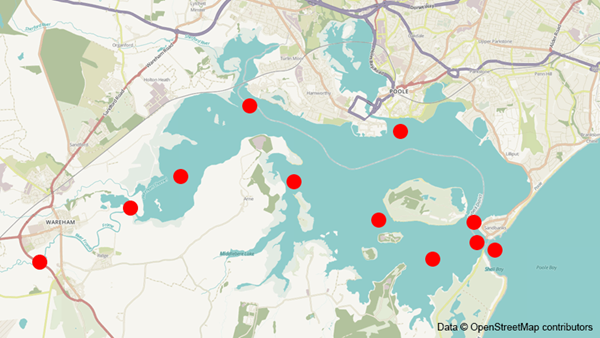
In addition to the receivers monitoring movement in the harbour, receivers were deployed in the River Frome at Bindon Mill, East Stoke, and at the tidal limit by the bypass around Wareham (see Map 2). These in-river receivers were deployed to monitor post tagging in-river loss rate and freshwater migration speed.
Map 2: Location of East Burton eel rack (yellow dot) and VR2W receivers in the River Frome (red dots)
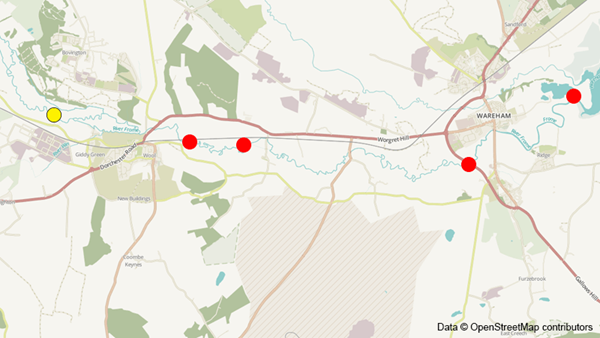
Capture and tagging of trout smolts
We acquired 50 V6 tags for the 2014 smolt run and another 50 tags for the 2015 smolt run. Tagging of the trout smolts is done at the eel rack at East Burton, 8km upstream of East Stoke. The eel rack represents a piece of cultural history as it was made many decades ago to trap downstream migrating silver eels for commercial purposes. It has been restored and is now an excellent tool for the GWCT to intercept downstream migrating fish in a fish-friendly manner. You can see a video of one in operation on the River Test on the BBC website.
The capture and tagging at the eel rack commenced on 28 March and was carried out at night, as this is when the majority of smolts migrate. The trout smolts were captured, anaesthetised, measured, weighed, had scales taken, had PIT and acoustic tag inserted, and were moved to a recovery tank and released when fully recovered (see photos of process below). The last of the 2014 tags were deployed on 23 April.
Photo 1: Trout smolt on measure board with acoustic (left) and PIT (right) tags
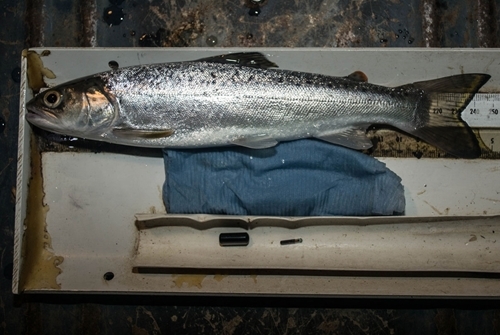
Photo 2: Insertion of acoustic tag
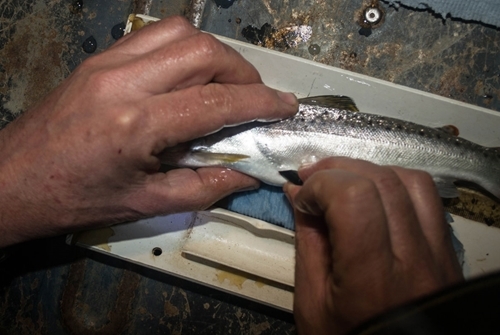
Photo 3: Trout post-surgery
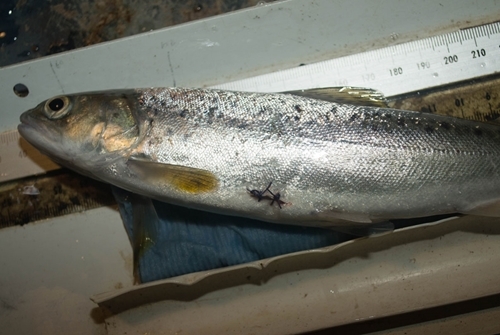
Tracking of tagged trout smolts
By 21 April, 70% of the tagged trout had been recorded entering the tidal section of the river. The battery life of the acoustic tags is 105 days from the day they are deployed, which will give us an excellent window into the migration behaviour of the tagged post-smolts in the near shore area. However, as the battery in the acoustic tags will run out before their first spawning migration, we also fitted the smolts with PIT tags, enabling us to record returning adults on our PIT readers at East Stoke and Bindon Mill.